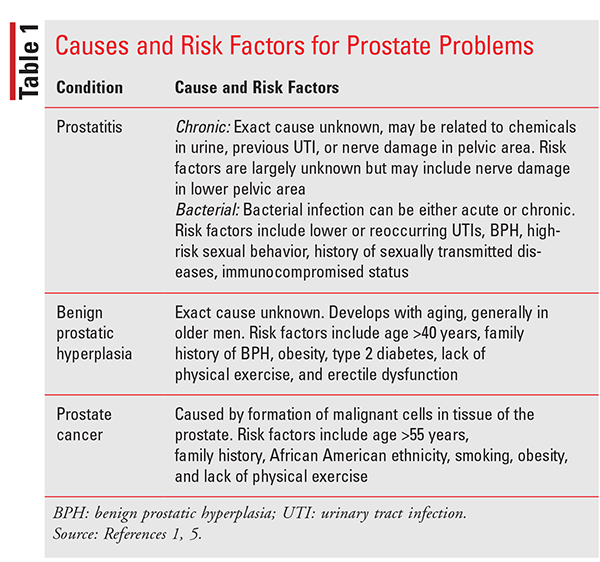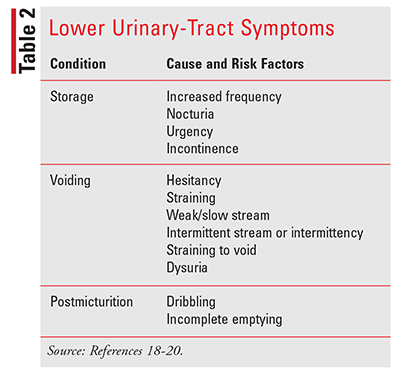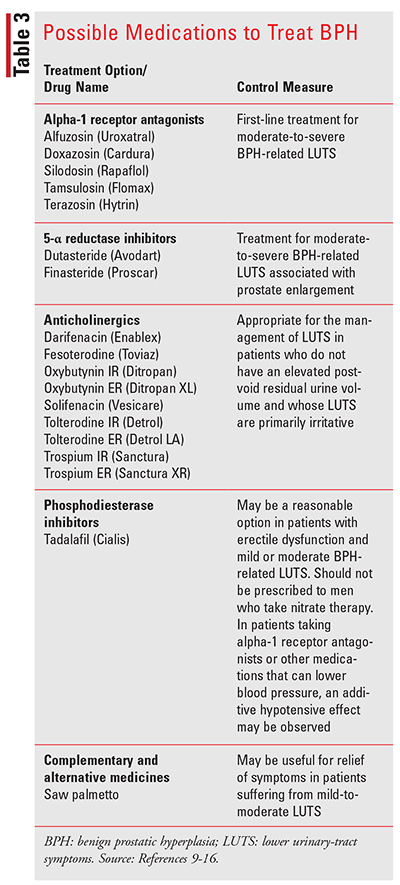The prostate is a walnut-sized gland in males located just below the bladder and in front of the rectum and wraps around the upper part of the urethra. It is responsible for producing seminal fluid that nourishes and transports sperm. It is vulnerable to three main conditions: prostatitis, benign prostatic hyperplasia (BPH), and prostate cancer, with BPH being the most common. Increase in prostate size is seen to correlate positively with increase in age, as significant growth generally begins after age 40 years and accelerates after age 60 years.1,2
Prostatitis encompasses a combination of conditions that can affect the prostate gland, causing pain, inflammation, swelling, and tenderness. This condition includes acute and chronic bacterial prostatitis, a chronic pelvic pain syndrome and asymptomatic inflammation. Prostatitis is the most common urinary tract problem for men younger than age 50 years and the third most common urinary tract problem for men older than age 50 years. Prostatitis causes over 2 million healthcare visits per year and affects 10% to 15% of the male population in the United States.
BPH is the enlargement of the prostate gland due to factors other than cancer. Many times, this can result from changing hormone levels as men age but it can also be the result of inflammation or fibrosis. The prevalence of BPH increases after age 40 years, affecting approximately 50% of men aged 51 to 60 years, and up to 90% of men older than age 80 years.
Finally, prostate cancer is the most common cancer and second-leading cancer cause of death in males in the U.S. Approximately 12.5% of men will be diagnosed with prostate cancer at some point in their lives. These conditions can be identified and treated early with proper screening and recognition of signs and symptoms. As pharmacists, we must be cognizant of and communicative with patients regarding the risks, to identify and treat as early as possible.3-5
Causes and Risk Factors
All men are at risk for developing prostate problems. Age and family history are some of the most common causes of prostate issues; obesity is another major contributor. Prostate cancer and BPH risks increase significantly in males who are older than age 50 years, with nearly 20% of prostate-cancer patients reporting a family history. Obesity is a modifiable risk factor that has been observed to be positively associated with prostate volume. Obesity contributes to increased inflammatory processes and increased intra-abdominal pressure, which contributes to the development of BPH and can worsen lower urinary-tract symptoms (LUTS). Obese patients have been shown to have a 3.5-fold increased risk of prostate enlargement compared with nonobese patients. Other factors such as physical inactivity, diet, and alteration in insulin levels also play a role in the development of BPH and prostate cancer. If prostate health is not managed, potential secondary complications of BPH can lead to renal insufficiency, kidney stones, and urinary tract infections (UTIs). TABLE 1 describes some of the more common risk factors for prostatitis, BPH, and prostate cancer.6-9

Clinical Presentation/Screening
Symptoms of a prostate condition commonly present as LUTS, including voiding or obstructive symptoms and increased frequency (TABLE 2). Patients suffering from chronic bacterial and nonbacterial prostatitis will usually experience LUTS, urogenital pain, psychological symptoms, and/or sexual dysfunction. Patients with acute bacterial prostatitis will often present with an acute onset of LUTS with or without suprapubic, rectal, or perineal pain. Systemic symptoms, including fever, chills, and malaise, are also common. Common symptoms of both BPH and prostate cancer include the urge to urinate many times during the day and night, urine flow that stops and starts, bladder pain, or weak urine stream.6,8,10-12

Identification of a prostate issue is usually made by a screening test. Screening tests are essential in early detection of BPH and prostate cancer. The U.S. Preventive Services Task Force does not currently recommend a digital rectal exam as a screening test because of lack of evidence of the benefits. In addition, men between the ages of 55 to 69 years have the right to decide whether to be screened periodically using the prostate-specific antigen test (PSA). The American Cancer Society recommends that men who choose to be tested who have a PSA less than 2.5 ng/mL may only need to be retested every 2 years, while men who have a PSA level greater than 2.5 ng/mL should be screened yearly. Screenings can be performed at routine checkups, and any issues that a patient may have with his prostate should also be addressed.8,13
Management
Acute prostatitis can be considered a subtype of a UTI. Most patients can be managed with outpatient antibiotics for 10 to 14 days, considering culture and sensitivity results. Antibiotics are also the mainstay of therapy for chronic bacterial prostatitis. The addition of an alpha blocker may help decrease recurrences of chronic bacterial prostatitis by reducing urinary obstruction. Management of chronic nonbacterial prostatitis consists of acetaminophen, uroselective alpha blockers, and possibly a 4- to 6-week trial of an antibiotic. While there are many pharmaceutical treatments for BPH and overall prostate health (TABLE 3), saw palmetto is a viable OTC option.10,11

Saw palmetto (Serenoa repens) is a tree native to the West Indies and the southeast coast of North America, and its berries are used medicinally. It has been studied as a possible therapy for the treatment of BPH and its symptoms. Traditional pharmaceutical options, such as alpha blockers or 5-α reductase inhibitors, offer proven benefit in decreasing prostate size and lowering PSA score, while also relieving symptoms. However, these drugs come along with side effects many patients find undesirable, such as decrease in sexual desire, and in the case of alpha-blockers, possible risk of cardiovascular effects. Published data determining saw palmetto’s efficacy in patients experiencing mild-to-moderate LUTS have been conflicting. In one trial, when studied against finasteride and placebo, saw palmetto showed improvement in urinary symptoms and flow compared with placebo and was similar in effect to finasteride. Alternatively, a 2012 Cochrane review of 32 randomized, controlled trials demonstrated that saw palmetto provided no improvement in nocturia, peak urine flow, and symptom scores for men with BPH when compared with placebo. Currently the American Urological Association does not recommend saw palmetto extracts in the management of BPH due to the lack of a clinically meaningful effect on LUTS secondary to BPH, based on the data that are available. While not as effective in reducing prostate size or PSA score, its benefits in symptom relief and additive therapeutic benefit may make it a feasible option in some patients.14-17
Role of the Pharmacist
Prostate conditions, specifically BPH, not only can be a concern for overall health but can come with bothersome side effects leading patients to seek the help of healthcare professionals. As accessible healthcare professionals, pharmacists have a responsibility not only to guide patients in OTC treatment options but also to identify signs and symptoms of a worsening condition. When evaluating a patient displaying characteristics of BPH or other prostate-related conditions, it is important to encourage examination of the prostate by the patient’s healthcare provider to gauge the severity of the disease and if pharmaceutical therapy is appropriate.
Alpha-blockers and 5-α reductase inhibitors are both strong options to treat prostate enlargement, as seen in BPH, prostate cancer, and chronic prostatitis. Bacterial prostatitis must be treated with antibiotics. If these alone are unable to relieve LUTS, anticholinergics and saw palmetto may be viable options. Studies of saw palmetto have demonstrated some efficacy in relieving urinary symptoms commonly associated with prostate disorders. Additionally, it carries mild-to-no side effects, making it a desirable option for patients. When counseling patients on saw palmetto, it is important to determine what other medications are being used by the patient and identify any possible drug interactions. Saw palmetto can potentiate the risk of bleeding and should be discussed with a provider before concomitant use with anticoagulants.
Most importantly, pharmacists should take an active role in monitoring how patients are responding to their prescribed therapy, helping to determine if their condition and symptoms are improving. Patient-reported outcomes are a good way to gauge the progress of a patient and are useful when counseling future patients.
Conclusion
Prostate-health conditions become most prevalent in the male population after age 40 years, and it is important to be proactive in identifying signs and symptoms of conditions like BPH, prostatitis, and prostate cancer. Management of prostate health focuses on lifestyle modifications and pharmacologic therapy. Pharmacists play an important role in the management of prostate health by educating patients on any medication-related problems, counseling on their drug therapy, and motivating patients to be adherent to their medications. Most importantly, pharmacists are there as a resource for the patient regarding prostate health and treatments and to provide support in the improvement of overall health.
The content contained in this article is for informational purposes only. The content is not intended to be a substitute for professional advice. Reliance on any information provided in this article is solely at your own risk.
REFERENCES
1. National Institute of Diabetes and Digestive and Kidney Diseases. Prostate problems. https://www.niddk.nih.gov/health-information/urologic-diseases/prostate-problems. Accessed August 9, 2021.
2. Zhang S-J, Qian H-N, Zhao Y, et al. Relationship between age and prostate size. Asian J Androl. 2013;15(1):116-120.
3. Krieger JN, Lee SWH, Jeon J, et al. Epidemiology of prostatitis. Int J Antimicrob Agents. 2008;31(Suppl 1):S85-S90.
4. Lim KB. Epidemiology of clinical benign prostatic hyperplasia. Asian J Urol. 2017;4(3):148-151.
5. Surveillance, Epidemiology, and End Results Program. Cancer of the prostate. Cancer stat facts. https://seer.cancer.gov/statfacts/html/prost.html. Accessed August 10, 2021.
6. Parsons JK. Benign prostatic hyperplasia and male lower urinary tract symptoms: epidemiology and risk factors. Curr Bladder Dysfunct Rep. 2010;5(4):212-218.
7. Rawla P. Epidemiology of prostate cancer. World J Oncol. 2019;10(2):63-89.
8. McVary KT, Roehrborn CG, Avins AL, et al. Update on AUA guideline on the management of benign prostatic hyperplasia. J Urol. 2011;185(5):1793-1803.
9. Lokeshwar SD, Harper BT, Webb E, et al. Epidemiology and treatment modalities for the management of benign prostatic hyperplasia. Transl Androl Urol. 2019;8(5):529-539.
10. Coker TJ, Dierfeldt DM. Acute bacterial prostatitis: diagnosis and management. Am Fam Physician. 2016;93(2):114-120.
11. Holt JD, Garrett WA, McCurry TK, Teichman JMH. Common questions about chronic prostatitis. Am Fam Physician. 2016;93(4):290-296.
To comment on this article, contact rdavidson@uspharmacist.com.

How Do I Know if I Have Prostate Problems?
The most common symptoms of prostate health problems include a weak or slow urinary stream, frequent urination, straining to urinate, and nighttime urgency to urinate. Depending on the type of prostate condition, you may experience other symptoms. You should immediately contact your doctor if you have one or more of the following: a weak urine stream, blood in your urine, fever, chilis or body aches, pain in your stomach, pain in the area between your scrotum and anus, pain while urinating or after ejaculation, inability to delay urination, or urine that has an unusual smell or color.
What Are Some Common Prostate Problems?
Three of the most common conditions that affect the prostate are prostatitis, benign prostatic hyperplasia (BPH), and prostate cancer. Prostatitis is an inflammation of the prostate gland. BPH occurs when the prostate gland enlarges. Prostate cancer can start anywhere in the prostate gland and is the most common type of cancer in men other than skin cancer.
What Are the Risk Factors for Prostate Problems?
Age, family history, and obesity are some of the most common causes of BPH and prostate cancer. Other causes include physical inactivity, diet, and alteration in insulin levels.
How Do I Reduce My Risks of Prostate Cancer and BPH?
You should see your healthcare provider regularly and notify the provider if you have any problems. Lose weight if you are obese. Exercise 30 minutes a day, five times a week. Maintain a healthy diet low in unhealthy fats and increase vegetable and fruit intake.
How Are Prostate Problems Treated?
Prostatitis can be caused by an infection or be noninfective. For infective prostatitis, antibiotics will be needed. For nonbacterial prostatitis, acetaminophen or ibuprofen may help ease the pain, and in some cases, antibiotics may also be recommended. Treatment for BPH includes lifestyle changes, medicine, and surgery. Some lifestyle changes include limiting liquids close to sleep, avoiding drinks with caffeine or alcohol, and avoiding certain medicines that can affect your bladder, such as cold and allergy medicines. Medications that may help reduce the size of your prostate include finasteride and dutasteride. Other medications such as tamsulosin, doxazosin, and alfuzosin help the prostate and bladder muscles relax, improving symptoms. If symptoms get worse despite making lifestyle adjustments and use of medication, surgery may be necessary to help shrink the prostate.
How Can I Prevent Prostate Problems?
Any male can develop prostate problems. There is really no way to prevent this. Prostatitis is more common in younger males, while BPH and prostate cancer more commonly affect men aged 50 years and older. If you have any risk factors, such as a family history, or are obese, you should talk to a healthcare provider as soon as you can if you are experiencing any lower urinary-tract symptoms. You should also speak to your healthcare provider about the need for regular prostate exams. Recognizing symptoms early may help you receive treatment earlier, reducing long-term complications.





